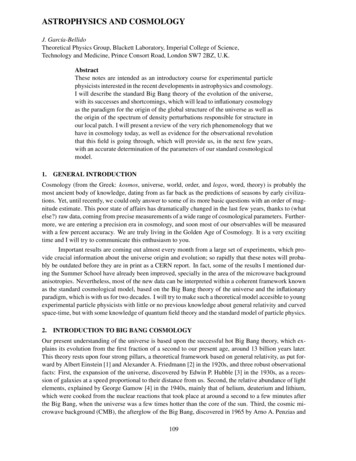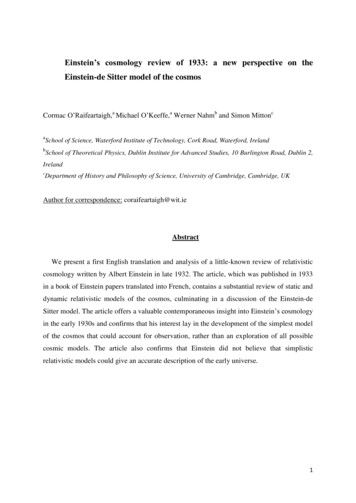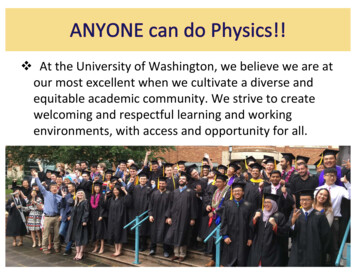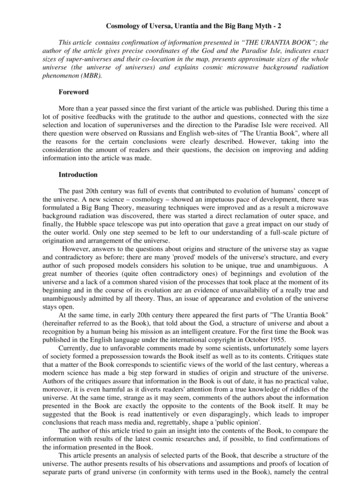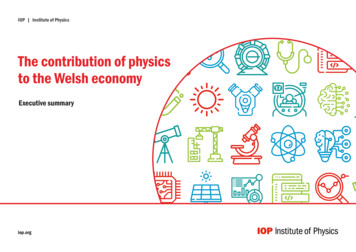
Transcription
Introductionto CosmologyThird EditionMatts Roos
Introductionto CosmologyThird Edition
Introductionto CosmologyThird EditionMatts Roos
Copyright 2003 John Wiley & Sons, Ltd, The Atrium, Southern Gate, Chichester,West Sussex PO19 8SQ, EnglandTelephone ( 44) 1243 779777Email (for orders and customer service enquiries): cs-books@wiley.co.ukVisit our Home Page on www.wileyeurope.com or www.wiley.comAll Rights Reserved. No part of this publication may be reproduced, stored in a retrievalsystem or transmitted in any form or by any means, electronic, mechanical, photocopying, recording, scanning or otherwise, except under the terms of the Copyright, Designsand Patents Act 1988 or under the terms of a licence issued by the Copyright LicensingAgency Ltd, 90 Tottenham Court Road, London W1T 4LP, UK, without the permission inwriting of the Publisher. Requests to the Publisher should be addressed to the PermissionsDepartment, John Wiley & Sons Ltd, The Atrium, Southern Gate, Chichester, West SussexPO19 8SQ, England, or emailed to permreq@wiley.co.uk, or faxed to ( 44) 1243 770571.This publication is designed to provide accurate and authoritative information in regardto the subject matter covered. It is sold on the understanding that the Publisher is notengaged in rendering professional services. If professional advice or other expert assistance is required, the services of a competent professional should be sought.Other Wiley Editorial OfficesJohn Wiley & Sons Inc., 111 River Street, Hoboken, NJ 07030, USAJossey-Bass, 989 Market Street, San Francisco, CA 94103-1741, USAWiley-VCH Verlag GmbH, Boschstr. 12, D-69469 Weinheim, GermanyJohn Wiley & Sons Australia Ltd, 33 Park Road, Milton, Queensland 4064, AustraliaJohn Wiley & Sons (Asia) Pte Ltd, 2 Clementi Loop #02-01, Jin Xing Distripark, Singapore129809John Wiley & Sons Canada Ltd, 22 Worcester Road, Etobicoke, Ontario, Canada M9W 1L1Wiley also publishes its books in a variety of electronic formats. Some content that appearsin print may not be available in electronic books.Library of Congress Cataloging-in-Publication DataRoos, Matts.Introduction to cosmology / Matt Roos. – 3rd ed.p. cm.Includes bibliographical references and index.ISBN 0-470-84909-6 (acid-free paper) – ISBN 0-470-84910-X (pbk. : acid-free paper)1. Cosmology. I. Title.QB981.R653 2003523.1 — dc222003020688British Library Cataloguing in Publication DataA catalogue record for this book is available from the British LibraryISBN 0 470 84909 6 (hardback)0 470 84910 X (paperback)Typeset in 9.5/12.5pt Lucida Bright by T&T Productions Ltd, London.Printed and bound in Great Britain by Antony Rowe Ltd., Chippenham, Wilts.This book is printed on acid-free paper responsibly manufactured from sustainableforestry in which at least two trees are planted for each one used for paper production.
To my dear grandchildrenFrancis Alexandre Wei Ming (1986)Christian Philippe Wei Sing (1990)Cornelia (1989)Erik (1991)Adrian (1994)Emile Johannes (2000)Alaia Ingrid Markuntytär (2002)
ContentsPreface to First EditionixPreface to Second EditionxiPreface to Third Edition1From Newton to Hubble1.11.21.31.41.51.62Historical CosmologyInertial Frames and the Cosmological PrincipleOlbers’ ParadoxHubble’s LawThe Age of the UniverseExpansion in a Newtonian World27912171925Lorentz Transformations and Special RelativityMetrics of Curved Space-timeRelativistic Distance MeasuresGeneral Relativity and the Principle of CovarianceThe Principle of EquivalenceEinstein’s Theory of Gravitation253037454954Gravitational 52.63xiii61Classical Tests of General RelativityThe Binary PulsarGravitational LensingBlack HolesGravitational Waves6263647180Cosmological Models4.14.24.34.487Friedmann–Lemaître Cosmologiesde Sitter CosmologyDark EnergyModel Testing and Parameter Estimation. IIntroduction to Cosmology Third Edition by Matts Roos 2003 John Wiley & Sons, LtdISBN 0 470 84909 6 (cased)8799101106ISBN 0 470 84910 X (pbk)
viii5ContentsThermal History of the Universe5.15.25.35.45.55.66PhotonsAdiabatic ExpansionElectroweak InteractionsThe Early Radiation EraPhoton and Lepton DecouplingBig Bang Nucleosynthesis114117122128132139Particles and Symmetries1496.16.26.36.46.56.66.77Paradoxes of the Expansion‘Old’ and ‘New’ InflationChaotic InflationThe Inflaton as QuintessenceCyclic ModelsCosmic Microwave Background8.18.28.38.49Spin SpaceSU(2) SymmetriesHadrons and QuarksThe Discrete Symmetries C, P, TSpontaneous Symmetry BreakingPrimeval Phase Transitions and SymmetriesBaryosynthesis and Antimatter GenerationCosmic Inflation7.17.27.37.47.58113The CMB TemperatureTemperature AnisotropiesPolarization AnisotropiesModel Testing and Parameter Estimation. IICosmic Structures and Dark Matter9.19.29.39.49.5Density FluctuationsStructure FormationThe Evidence for Dark MatterDark Matter CandidatesThe Cold Dark Matter Paradigm10 Epilogue10.110.2SingularitiesOpen ndex271
Preface to First EditionA few decades ago, astronomy and particle physics started to merge in the common field of cosmology. The general public had always been more interested inthe visible objects of astronomy than in invisible atoms, and probably met cosmology first in Steven Weinberg’s famous book The First Three Minutes. More recentlyStephen Hawking’s A Brief History of Time has caused an avalanche of interest inthis subject.Although there are now many popular monographs on cosmology, there areso far no introductory textbooks at university undergraduate level. Chapters oncosmology can be found in introductory books on relativity or astronomy, butthey cover only part of the subject. One reason may be that cosmology is explicitlycross-disciplinary, and therefore it does not occupy a prominent position in eitherphysics or astronomy curricula.At the University of Helsinki I decided to try to take advantage of the greatinterest in cosmology among the younger students, offering them a one-semestercourse about one year before their specialization started. Hence I could not counton much familiarity with quantum mechanics, general relativity, particle physics,astrophysics or statistical mechanics. At this level, there are courses with thegeneric name of Structure of Matter dealing with Lorentz transformations andthe basic concepts of quantum mechanics. My course aimed at the same level. Itsmain constraint was that it had to be taught as a one-semester course, so that itwould be accepted in physics and astronomy curricula. The present book is basedon that course, given three times to physics and astronomy students in Helsinki.Of course there already exist good books on cosmology. The reader will in factfind many references to such books, which have been an invaluable source ofinformation to me. The problem is only that they address a postgraduate audiencethat intends to specialize in cosmology research. My readers will have to turn tothese books later when they have mastered all the professional skills of physicsand mathematics.In this book I am not attempting to teach basic physics to astronomers. Theywill need much more. I am trying to teach just enough physics to be able to explainthe main ideas in cosmology without too much hand-waving. I have tried to avoidthe other extreme, practised by some of my particle physics colleagues, of writingbooks on cosmology with the obvious intent of making particle physicists out ofevery theoretical astronomer.Introduction to Cosmology Third Edition by Matts Roos 2003 John Wiley & Sons, LtdISBN 0 470 84909 6 (cased)ISBN 0 470 84910 X (pbk)
xPreface to First EditionI also do not attempt to teach basic astronomy to physicists. In contrast toastronomy scholars, I think the main ideas in cosmology do not require verydetailed knowledge of astrophysics or observational techniques. Whole bookshave been written on distance measurements and the value of the Hubble parameter, which still remains imprecise to a factor of two. Physicists only need to knowthat quantities entering formulae are measurable—albeit incorporating factors hto some power—so that the laws can be discussed meaningfully. At undergraduatelevel, it is not even usual to give the errors on measured values.In most chapters there are subjects demanding such a mastery of theoreticalphysics or astrophysics that the explanations have to be qualitative and the derivations meagre, for instance in general relativity, spontaneous symmetry breaking,inflation and galaxy formation. This is unavoidable because it just reflects thelevel of undergraduates. My intention is to go just a few steps further in thesematters than do the popular monographs.I am indebted in particular to two colleagues and friends who offered constructive criticism and made useful suggestions. The particle physicist Professor KariEnqvist of NORDITA, Copenhagen, my former student, has gone to the troubleof reading the whole manuscript. The space astronomer Professor Stuart Bowyerof the University of California, Berkeley, has passed several early mornings of jetlag in Lapland going through the astronomy-related sections. Anyway, he couldnot go out skiing then because it was either a snow storm or 30 C! Finally, thepublisher provided me with a very knowledgeable and thorough referee, an astrophysicist no doubt, whose criticism of the chapter on galaxy formation was veryvaluable to me. For all remaining mistakes I take full responsibility. They may wellhave been introduced by me afterwards.Thanks are also due to friends among the local experts: particle physicist Professor Masud Chaichian and astronomer Professor Kalevi Mattila have helped mewith details and have answered my questions on several occasions. I am alsoindebted to several people who helped me to assemble the pictorial material:Drs Subir Sarkar in Oxford, Rocky Kolb in the Fermilab, Carlos Frenk in Durham,Werner Kienzle at CERN and members of the COBE team.Finally, I must thank my wife Jacqueline for putting up with almost two yearsof near absence and full absent-mindedness while writing this book.Matts Roos
Preface to Second EditionIn the three years since the first edition of this book was finalized, the field ofcosmology has seen many important developments, mainly due to new observations with superior instruments such as the Hubble Space Telescope and theground-based Keck telescope and many others. Thus a second edition has becomenecessary in order to provide students and other readers with a useful and up-todate textbook and reference book.At the same time I could balance the presentation with material which wasnot adequately covered before—there I am in debt to many readers. Also, theinevitable number of misprints, errors and unclear formulations, typical of a firstedition, could be corrected. I am especially indebted to Kimmo Kainulainen whoserved as my course assistant one semester, and who worked through the bookand the problems thoroughly, resulting in a very long list of corrigenda. A similarshorter list was also dressed by George Smoot and a student of his. It still worriesme that the errors found by George had been found neither by Kimmo nor bymyself, thus statistics tells me that some errors still will remain undetected.For new pictorial material I am indebted to Wes Colley at Princeton, Carlos Frenkin Durham, Charles Lineweaver in Strasbourg, Jukka Nevalainen in Helsinki, SubirSarkar in Oxford, and George Smoot in Berkeley. I am thankful to the Academiedes Sciences for an invitation to Paris where I could visit the Observatory of ParisMeudon and profit from discussions with S. Bonazzola and Brandon Carter.Several of my students have contributed in various ways: by misunderstandings,indicating the need for better explanations, by their enthusiasm for the subject,and by technical help, in particular S. M. Harun-or-Rashid. My youngest grandchildAdrian (not yet 3) has showed a vivid interest for supernova bangs, as demonstrated by an X-ray image of the Cassiopeia A remnant. Thus the future of thesubject is bright.Matts RoosIntroduction to Cosmology Third Edition by Matts Roos 2003 John Wiley & Sons, LtdISBN 0 470 84909 6 (cased)ISBN 0 470 84910 X (pbk)
Preface to Third EditionThis preface can start just like the previous one: in the seven years since thesecond edition was finalized, the field of cosmology has seen many importantdevelopments, mainly due to new observations with superior instruments. In thepast, cosmology often relied on philosophical or aesthetic arguments; now it ismaturing to become an exact science. For example, the Einstein–de Sitter universe,which has zero cosmological constant (Ωλ 0), used to be favoured for estheticalreasons, but today it is known to be very different from zero (Ωλ 0.73 0.04).In the first edition I quoted Ω0 0.8 0.3 (daring to believe in errors that manyothers did not), which gave room for all possible spatial geometries: spherical, flatand hyperbolic. Since then the value has converged to Ω0 1.02 0.02, and everybody is now willing to concede that the geometry of the Universe is flat, Ω0 1.This result is one of the cornerstones of what we now can call the ‘Standard Modelof Cosmology’. Still, deep problems remain, so deep that even Einstein’s generalrelativity is occasionally put in doubt.A consequence of the successful march towards a ‘standard model’ is that manyalternative models can be discarded. An introductory text of limited length likethe current one cannot be a historical record of failed models. Thus I no longerdiscuss, or discuss only briefly, k 0 geometries, the Einstein–de Sitter universe,hot and warm dark matter, cold dark matter models with Λ 0, isocurvature fluctuations, topological defects (except monopoles), Bianchi universes, and formulaewhich only work in discarded or idealized models, like Mattig’s relation and theSaha equation.Instead, this edition contains many new or considerably expanded subjects: Section 2.3 on Relativistic Distance Measures, Section 3.3 on Gravitational Lensing,Section 3.5 on Gravitational Waves, Section 4.3 on Dark Energy and Quintessence,Section 5.1 on Photon Polarization, Section 7.4 on The Inflaton as Quintessence,Section 7.5 on Cyclic Models, Section 8.3 on CMB Polarization Anisotropies, Section 8.4 on model testing and parameter estimation using mainly the first-yearCMB results of the Wilkinson Microwave Anisotropy Probe, and Section 9.5 onlarge-scale structure results from the 2 degree Field (2dF) Galaxy Redshift Survey.The synopsis in this edition is also different and hopefully more logical, much hasbeen entirely rewritten, and all parameter values have been updated.I have not wanted to go into pure astrophysics, but the line between cosmologyand cosmologically important astrophysics is not easy to draw. Supernova explosion mechanisms and black holes are included as in the earlier editions, but notIntroduction to Cosmology Third Edition by Matts Roos 2003 John Wiley & Sons, LtdISBN 0 470 84909 6 (cased)ISBN 0 470 84910 X (pbk)
xivPreface to Third Editionfor instance active galactic nuclei (AGNs) or jets or ultra-high-energy cosmic rays.Observational techniques are mentioned only briefly—they are beyond the scopeof this book.There are many new figures for which I am in debt to colleagues and friends,all acknowledged in the figure legends. I have profited from discussions with Professor Carlos Frenk at the University of Durham and Professor Kari Enqvist atthe University of Helsinki. I am also indebted to Professor Juhani Keinonen at theUniversity of Helsinki for having generously provided me with working space andaccess to all the facilities at the Department of Physical Sciences, despite the factthat I am retired.Many critics, referees and other readers have made useful comments that I havetried to take into account. One careful reader, Urbana Lopes França Jr, sent mea long list of misprints and errors. A critic of the second edition stated that theerrors in the first edition had been corrected, but that new errors had emergedin the new text. This will unfortunately always be true in any comparison of edition n 1 with edition n. In an attempt to make continuous corrections I haveassigned a web site for a list of errors and misprints. The address ishttp://www.physics.helsinki.fi/ fl cosmo/My most valuable collaborator has been Thomas S. Coleman, a nonphysicist whocontacted me after having spotted some errors in the second edition, and whoproposed some improvements in case I were writing a third edition. This cameat the appropriate time and led to a collaboration in which Thomas S. Colemanread the whole manuscript, corrected misprints, improved my English, checkedmy calculations, designed new figures and proposed clarifications where he foundthe text difficult.My wife Jacqueline has many interesting subjects of conversation at the breakfast table. Regretfully, her breakfast companion is absent-minded, thinking onlyof cosmology. I thank her heartily for her kind patience, promising improvement.Matts RoosHelsinki, March 2003
1From Newton toHubbleThe history of ideas on the structure and origin of the Universe shows thathumankind has always put itself at the centre of creation. As astronomical evidence has accumulated, these anthropocentric convictions have had to be abandoned one by one. From the natural idea that the solid Earth is at rest and thecelestial objects all rotate around us, we have come to understand that we inhabitan average-sized planet orbiting an average-sized sun, that the Solar System is inthe periphery of a rotating galaxy of average size, flying at hundreds of kilometresper second towards an unknown goal in an immense Universe, containing billionsof similar galaxies.Cosmology aims to explain the origin and evolution of the entire contents ofthe Universe, the underlying physical processes, and thereby to obtain a deeperunderstanding of the laws of physics assumed to hold throughout the Universe.Unfortunately, we have only one universe to study, the one we live in, and wecannot make experiments with it, only observations. This puts serious limits onwhat we can learn about the origin. If there are other universes we will never know.Although the history of cosmology is long and fascinating, we shall not trace itin detail, nor any further back than Newton, accounting (in Section 1.1) only forthose ideas which have fertilized modern cosmology directly, or which happenedto be right although they failed to earn timely recognition. In the early days ofcosmology, when little was known about the Universe, the field was really just abranch of philosophy.Having a rigid Earth to stand on is a very valuable asset. How can we describemotion except in relation to a fixed point? Important understanding has comefrom the study of inertial systems, in uniform motion with respect to one another.From the work of Einstein on inertial systems, the theory of special relativityIntroduction to Cosmology Third Edition by Matts Roos 2003 John Wiley & Sons, LtdISBN 0 470 84909 6 (cased)ISBN 0 470 84910 X (pbk)
2From Newton to Hubblewas born. In Section 1.2 we discuss inertial frames, and see how expansion andcontraction are natural consequences of the homogeneity and isotropy of theUniverse.A classic problem is why the night sky is dark and not blazing like the disc ofthe Sun, as simple theory in the past would have it. In Section 1.3 we shall discussthis so-called Olbers’ paradox, and the modern understanding of it.The beginning of modern cosmology may be fixed at the publication in 1929of Hubble’s law, which was based on observations of the redshift of spectrallines from remote galaxies. This was subsequently interpreted as evidence forthe expansion of the Universe, thus ruling out a static Universe and thereby setting the primary requirement on theory. This will be explained in Section 1.4. InSection 1.5 we turn to determinations of cosmic timescales and the implicationsof Hubble’s law for our knowledge of the age of the Universe.In Section 1.6 we describe Newton’s theory of gravitation, which is the earliestexplanation of a gravitational force. We shall ‘modernize’ it by introducing Hubble’s law into it. In fact, we shall see that this leads to a cosmology which alreadycontains many features of current Big Bang cosmologies.1.1Historical CosmologyAt the time of Isaac Newton (1642–1727) the heliocentric Universe of NicolausCopernicus (1473–1543), Galileo Galilei (1564–1642) and Johannes Kepler (1571–1630) had been accepted, because no sensible description of the motion of theplanets could be found if the Earth was at rest at the centre of the Solar System.Humankind was thus dethroned to live on an average-sized planet orbiting aroundan average-sized sun.The stars were understood to be suns like ours with fixed positions in a staticUniverse. The Milky Way had been resolved into an accumulation of faint starswith the telescope of Galileo. The anthropocentric view still persisted, however,in locating the Solar System at the centre of the Universe.Newton’s Cosmology. The first theory of gravitation appeared when Newtonpublished his Philosophiae Naturalis Principia Mathematica in 1687. With thistheory he could explain the empirical laws of Kepler: that the planets moved inelliptical orbits with the Sun at one of the focal points. An early success of thistheory came when Edmund Halley (1656–1742) successfully predicted that thecomet sighted in 1456, 1531, 1607 and 1682 would return in 1758. Actually, thefirst observation confirming the heliocentric theory came in 1727 when JamesBradley (1693–1762) discovered the aberration of starlight, and explained it asdue to the changes in the velocity of the Earth in its annual orbit. In our time,Newton’s theory of gravitation still suffices to describe most of planetary andsatellite mechanics, and it constitutes the nonrelativistic limit of Einstein’s relativistic theory of gravitation.
Historical Cosmology3Newton considered the stars to be suns evenly distributed throughout infinitespace in spite of the obvious concentration of stars in the Milky Way. A distribution is called homogeneous if it is uniformly distributed, and it is calledisotropic if it has the same properties in all spatial directions. Thus in a homogeneous and isotropic space the distribution of matter would look the same toobservers located anywhere—no point would be preferential. Each local region ofan isotropic universe contains information which remains true also on a globalscale. Clearly, matter introduces lumpiness which grossly violates homogeneityon the scale of stars, but on some larger scale isotropy and homogeneity maystill be a good approximation. Going one step further, one may postulate what iscalled the cosmological principle, or sometimes the Copernican principle.The Universe is homogeneous and isotropic in three-dimensional space,has always been so, and will always remain so.It has always been debated whether this principle is true, and on what scale.On the galactic scale visible matter is lumpy, and on larger scales galaxies formgravitationally bound clusters and narrow strings separated by voids. But galaxiesalso appear to form loose groups of three to five or more galaxies. Several surveyshave now reached agreement that the distribution of these galaxy groups appearsto be homogeneous and isotropic within a sphere of 170 Mpc radius [1]. This isan order of magnitude larger than the supercluster to which our Galaxy and ourlocal galaxy group belong, and which is centred in the constellation of Virgo.Based on his theory of gravitation, Newton formulated a cosmology in 1691.Since all massive bodies attract each other, a finite system of stars distributedover a finite region of space should collapse under their mutual attraction. Butthis was not observed, in fact the stars were known to have had fixed positionssince antiquity, and Newton sought a reason for this stability. He concluded, erroneously, that the self-gravitation within a finite system of stars would be compensated for by the attraction of a sufficient number of stars outside the system,distributed evenly throughout infinite space. However, the total number of starscould not be infinite because then their attraction would also be infinite, makingthe static Universe unstable. It was understood only much later that the additionof external layers of stars would have no influence on the dynamics of the interior.The right conclusion is that the Universe cannot be static, an idea which wouldhave been too revolutionary at the time.Newton’s contemporary and competitor Gottfried Wilhelm von Leibnitz (1646–1716) also regarded the Universe to be spanned by an abstract infinite space, butin contrast to Newton he maintained that the stars must be infinite in numberand distributed all over space, otherwise the Universe would be bounded andhave a centre, contrary to contemporary philosophy. Finiteness was consideredequivalent to boundedness, and infinity to unboundedness.Rotating Galaxies. The first description of the Milky Way as a rotating galaxycan be traced to Thomas Wright (1711–1786), who wrote An Original Theory orNew Hypothesis of the Universe in 1750, suggesting that the stars are
4From Newton to Hubbleall moving the same way and not much deviating from the same plane,as the planets in their heliocentric motion do round the solar body.Wright’s galactic picture had a direct impact on Immanuel Kant (1724–1804). In1755 Kant went a step further, suggesting that the diffuse nebulae which Galileohad already observed could be distant galaxies rather than nearby clouds of incandescent gas. This implied that the Universe could be homogeneous on the scaleof galactic distances in support of the cosmological principle.Kant also pondered over the reason for transversal velocities such as the movement of the Moon. If the Milky Way was the outcome of a gaseous nebula contracting under Newton’s law of gravitation, why was all movement not directedtowards a common centre? Perhaps there also existed repulsive forces of gravitation which would scatter bodies onto trajectories other than radial ones, andperhaps such forces at large distances would compensate for the infinite attraction of an infinite number of stars? Note that the idea of a contracting gaseousnebula constituted the first example of a nonstatic system of stars, but at galacticscale with the Universe still static.Kant thought that he had settled the argument between Newton and Leibnitzabout the finiteness or infiniteness of the system of stars. He claimed that eithertype of system embedded in an infinite space could not be stable and homogeneous, and thus the question of infinity was irrelevant. Similar thoughts can betraced to the scholar Yang Shen in China at about the same time, then unknownto Western civilization [2].The infinity argument was, however, not properly understood until BernhardRiemann (1826–1866) pointed out that the world could be finite yet unbounded,provided the geometry of the space had a positive curvature, however small. Onthe basis of Riemann’s geometry, Albert Einstein (1879–1955) subsequently established the connection between the geometry of space and the distribution of matter.Kant’s repulsive force would have produced trajectories in random directions,but all the planets and satellites in the Solar System exhibit transversal motion inone and the same direction. This was noticed by Pierre Simon de Laplace (1749–1827), who refuted Kant’s hypothesis by a simple probabilistic argument in 1825:the observed movements were just too improbable if they were due to randomscattering by a repulsive force. Laplace also showed that the large transversalvelocities and their direction had their origin in the rotation of the primordialgaseous nebula and the law of conservation of angular momentum. Thus no repulsive force is needed to explain the transversal motion of the planets and theirmoons, no nebula could contract to a point, and the Moon would not be expectedto fall down upon us.This leads to the question of the origin of time: what was the first cause of therotation of the nebula and when did it all start? This is the question modern cosmology attempts to answer by tracing the evolution of the Universe backwards intime and by reintroducing the idea of a repulsive force in the form of a cosmological constant needed for other purposes.
Historical Cosmology5Black Holes. The implications of Newton’s gravity were quite well understoodby John Michell (1724–1793), who pointed out in 1783 that a sufficiently massiveand compact star would have such a strong gravitational field that nothing couldescape from its surface. Combining the corpuscular theory of light with Newton’stheory, he found that a star with the solar density and escape velocity c wouldhave a radius of 486R and a mass of 120 million solar masses. This was the firstmention of a type of star much later to be called a black hole (to be discussed inSection 3.4). In 1796 Laplace independently presented the same idea.Galactic and Extragalactic Astronomy. Newton should also be credited withthe invention of the reflecting telescope—he even built one—but the first one ofimportance was built one century later by William Herschel (1738–1822). Withthis instrument, observational astronomy took a big leap forward: Herschel andhis son John could map the nearby stars well enough in 1785 to conclude correctly that the Milky Way was a disc-shaped star system. They also concludederroneously that the Solar System was at its centre, but many more observationswere needed before it was corrected. Herschel made many important discoveries,among them the planet Uranus, and some 700 binary stars whose movementsconfirmed the validity of Newton’s theory of gravitation outside the Solar System.He also observed some 250 diffuse nebulae, which he first believed were distantgalaxies, but which he and
books on cosmology with the obvious intent of making particle physicists out of every theoretical astronomer. x Preface to First Edition I also do not attempt to teach basic astronomy to physicists. In contrast to astronomy scholars, I think the main ideas in cosmology do not require very
